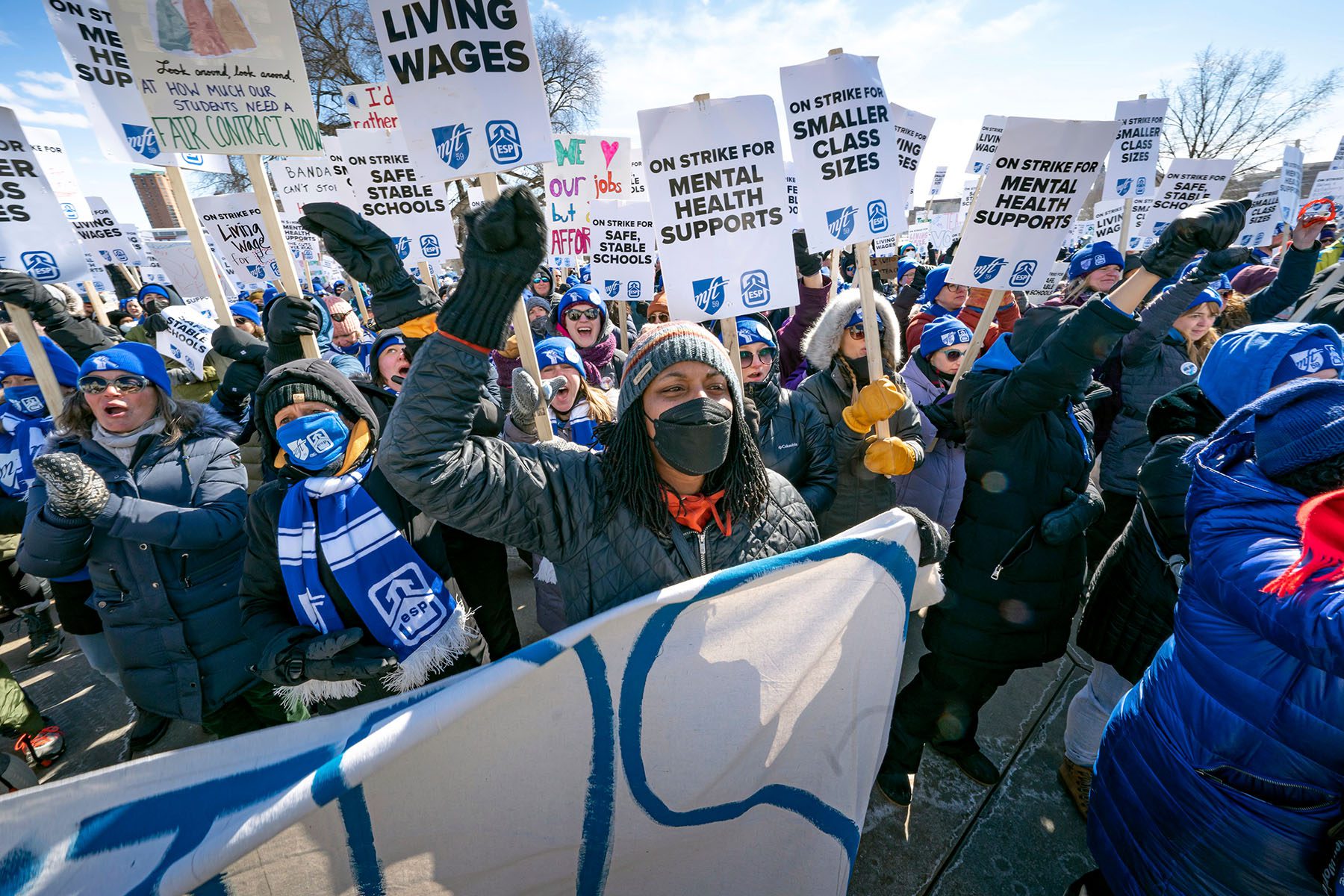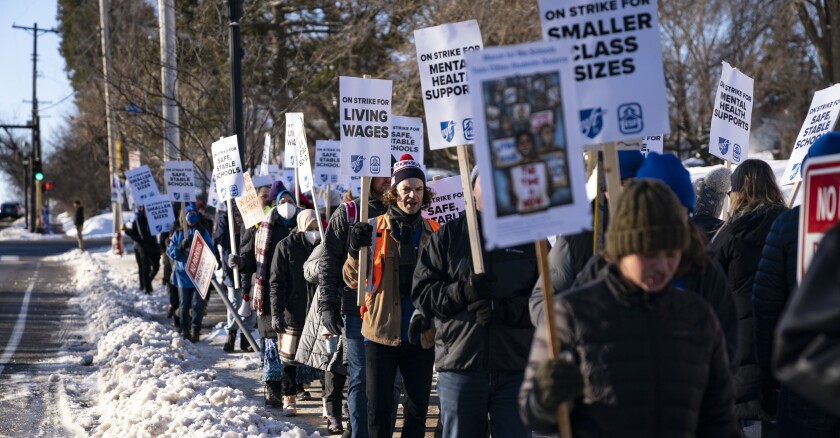Ma-Riah Roberson-Moody, an education support professional for Minneapolis Public Schools, works two other jobs to make ends meet. The school district doesn’t pay her enough to survive on one salary, she said.
Some of her peers are not even able to afford basic necessities.
On average, education support professionals in Minneapolis Public Schools earn just $24,000 annually, she said, despite labor-intensive work that includes feeding students, assisting them in the bathroom, helping them with classwork, and providing before- and after-school care.
Since Tuesday, these professionals and the teachers of Minneapolis Public Schools have been on strike, the first teachers strike in the city in 50 years. Their demands include smaller class sizes, better benefits, more mental health resources for students, increased workforce diversity and higher wages.
Collectively, the demands of the 4,500 striking Minneapolis educators reflect the broad concerns of their colleagues nationally, making more strikes imminent, labor experts predict. In fact, teachers in two suburban Chicago districts — George Patton School District 133 and Proviso Township High School District 209 — both began strikes over the past two weeks. On Thursday, educators in a Sonoma County, California, school district went on strike for better wages, and on that same day teachers in Sacramento, California, voted to authorize a strike, a formality needed before an actual walkout.
“The pressure on teachers right now is so formidable with regards to COVID in particular as well as right-wing harassment that I would say their tempers are much more frayed,” said Stephanie Seguino, an economics professor at the University of Vermont. “It wouldn’t surprise me if we did see more strikes because teachers have reached their limit.”
Bradley D. Marianno, an assistant professor in Educational Policy & Leadership at the University of Nevada, Las Vegas, said that the national educator shortage gives teachers and other school personnel bargaining power.
“I’m not surprised that there is a call for higher raises, more paraprofessional support or lower class sizes,” he said. “They may not get all of those items, but they certainly are in a powerful position to make those demands because it’s really hard for districts to find teachers right now.”
In addition to the teacher shortage, the COVID-19 pandemic resulted in teachers negotiating about unprecedented classroom concerns, such as masking, vaccinations, remote learning and hybrid learning, Marianno said. In the Minneapolis, Oakland and Chicago public school districts, negotiations grew particularly tense in January. Leaders in both the Minneapolis and Oakland teachers unions said they were prepared to strike then, while Chicago teachers were accused of illegally striking for refusing to work in conditions they alleged were unsafe.
“Anytime there’s labor tension negotiations, while it may be acute to a specific topic of discussion, like masking policy, it tends to exist for some time beyond that and influence the next round of negotiations,” Marianno said. “There’s an institutional memory for any tension around these negotiations.”
School officials have tried to mitigate some of the pressures. Over the past year, multiple states have raised pay to retain school personnel as COVID-19 and bills that place restrictions on teaching curricula push educators out of classrooms. School districts nationwide have closed for mental health days, citing the needs of students and staff alike, and educators have highlighted the importance of a diverse workforce after the masive demonstrations that followed the 2020 Minneapolis police murder of George Floyd.
But sometimes the measures are not enough.
In Minneapolis, the demands in pay vary by job designation. Teachers are asking for nearly a 20 percent raise over a two-year period. Their average annual salary is $71,500, lower than neighboring districts that offer teachers salaries upward of $80,000 per year. Meanwhile, education support professionals are picketing for a starting salary of $35,000. Roberson-Moody said that nearly two-thirds of education support professionals have two or more jobs to pad their earnings from Minneapolis Public Schools.
“So to be able to just have one job would allow our members to have time to take care of themselves, to be with their own families, to better prepare for the next day, because in our jobs, we deal with a lot of different things and support students in a lot of different ways,” she said. “When we’re extremely tired because we were working the previous night to make ends meet, our students see that and they’re affected by that.”
The low wages education support professionals receive also make it difficult for them to pay for their district health insurance plans, which cost them the same as administrators who earn five times their salaries, Roberson-Moody said. Some education support professionals pay more than $700 monthly for their family health insurance plans, leaving them with little money to pay for other expenses. About half of Minneapolis education support professionals are people of color, compared with roughly 20 percent of public school teachers, and both groups are largely women.

“The data are very clear that the larger the percentage of women in a professional occupation, the lower is the salary,” Seguino said. “There’s a gender hierarchy just like there is a racial hierarchy. Many presume the skills women have in occupations like teaching or childcare work or nursing are innate and that women are naturally good at caring for people. Therefore, there’s a sense that we don’t really need to compensate for that. So, it’s gender stereotyping that really holds down wages.”
Along with higher pay, Roberson-Moody wants Minneapolis Public Schools to take steps to better serve students. That includes more mental health resources in a district where it’s not uncommon for one school counselor to have a caseload of up to 350 students. Minneapolis Public Schools Superintendent Ed Graff has said that the district is reserving some of its $90 million in federal COVID relief funding for mental health resources. But educators also want smaller class sizes for students. A six-year district employee, Roberson-Moody said that it’s difficult for students to learn in huge classes and for educators to give them the support they need.
“We’re in those classes and we see how that affects students, so that’s really important,” she said.
Seguino said that when teachers strike, they very often do so on behalf of students.
“In many ways, it’s not focused so much on individual teacher benefits, but the teachers are willing to go on strike to get the conditions that will improve the educational attainment of children,” she said. “The backlash against critical race theory, for example, is an invasion of teachers’ ability to determine as skilled professionals the curriculum for students. So, there’s certainly the stress of that, but teachers are also striking on behalf of children, and I think we have to remember that.”
Jennifer Davis, a parent of a 12-year-old girl who attends Minneapolis Public Schools, is not as impressed by the striking teachers. She said that she’s worried about how her daughter’s education will be affected by the missed days of school. She’s also had to find childcare for her daughter during the strike. A family education teacher for St. Paul Public Schools, where educators also came close to striking this month, Davis said Minneapolis teachers should primarily be focused on improving literacy rates. She believes many of the demands they’re making are unattainable, although she does support raises for low-wage school personnel.
“The fact that folks are making $12 an hour is just unnerving to me,” she said. “That is disrespectful.”
But she doubts that it’s feasible for Minneapolis Public Schools to meet the striking teachers’ demands if the district doesn’t have the money or personnel to implement these changes.
“They seem totally ungrounded in reality,” she said.
Marianno said that labor unions typically start strikes by making a laundry list of demands, even if some requests seem out of reach.
“What you do in these situations is you ask for well beyond what you think you’re going to arrive at,” he said. “With typical negotiation tactics, you’re not going to start with where you think you can get to. You’re going to ask for as much as possible, and, then, in the give-and-take process of collective bargaining negotiations, probably arrive at a different number. But, on the whole, the teachers are able to ask for more right now because the labor shortage in education places a strain on the system.”
The superintendent said during a Wednesday news conference that the teachers’ demands would add $166 million annually to the expenditures currently budgeted for next school year, but he did commit to raising wages for education support professionals.
“We do have shared values — that’s very apparent to me, board members and the public. Unfortunately, the reality is we’re resource-limited,” Graff said. “The finances we have are not enough to provide the support we need to provide.”
Graff also implied that the state could intervene, stressing that the school district cannot afford to make the changes educators seek without outside help. On the same day as his news conference, about 2,000 Minneapolis educators and their allies demonstrated at the state capitol to call on the state to use its $9.25 billion surplus to support public schools.
Taking part in labor actions can influence teachers beyond the classroom. Engaging in strikes often lead teachers to enter politics more broadly, according to a study Marianno co-authored this year that examined teachers who participated in dozens of strikes during 2018. That year, the Supreme Court ruled in the Janus v. American Federation of State, County and Municipal Employees that unions could not collect mandatory fees for bargaining on behalf of nonunion members, a financial blow to labor organizations. Despite the setback, labor unions attracted new members and saw an increase in walkout activity that correlated with women teachers seeking elected office, Marianno found. During the 2018 midterm elections, women teachers-turned-political candidates won 61 legislative seats, representing about 3 percent of the 1,839 seats women gained in the state legislature that year, according to his study.
“So these types of movements have political repercussions for representation in government,” Marianno said. “Women teachers actually applied for and won state legislative seats as a part of the walkout movement that occurred in 2018 in a way that changed the gender composition of the legislature.”
Roberson-Moody has yet to express any aspirations to run for public office. For now, her immediate goal is to get a raise, an outcome that would dramatically change the lives of Minneapolis Public Schools education support professionals, she said.
“This would be really, really big, not only because we would be able to just better support ourselves with our job, but, also, it would show some respect from our district for the work that we do.”
This article was first published by The 19th. Read the original article.











